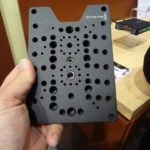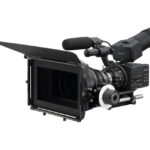
REVIEW – CANON XA10 CAMCORDER
Posted on Sep 20, 2011 by Alex Fice
Taking a preproduction model of a camera to the inhospitable wastes of the Arctic as a back-up is probably not one of the best ideas going. PHIL COATES justifies his decision.
It’s funny what comes out of the woodwork when you’re trying to do something radically different. Over the years I have become accustomed to seeking out the highest quality cameras with the smallest weight for expedition style productions around the world.
This job however was going to be a little different. As an embedded director cameraman on the Catlin Arctic Survey I had to be completely self sufficient and be able to ski and haul all my broadcast kit behind me in a specially designed sled. Lightweight kit was imperative.
The survey was an international scientific expedition aiming to improve our understanding of the processes going on in the sea ice of the high Arctic Ocean and I wanted to shoot this on HD. In January 2011 this seemed a little far fetched until something came out of the woodwork.
I had been looking around for a compact camera that I could use in a chest pouch while skiing and also use as a video diary cam or a B-roll cam for my fellow expedition members to use. Normally I would have to compromise quality when choosing such a small unit for such application however I chanced upon the new Canon XA10.
On first impressions the XA10 looked perfect with two XLR inputs on the handle and a very small footprint, however I must admit I did wonder whether this little prosumer style camera would stand up to the rigours of expedition filmmaking. I shouldn’t have worried…
The main thing I was concerned about was the fact that the Canon XA10 uses a LCD touch screen interface for most of the camera settings. Usually in my line of work the sun is too bright for me to see the LCD or it’s too cold for the liquid in the liquid crystal display to actually function.
Well not only did the XA10 work in one of the most hostile environments on earth, I frankly would not have been able to complete the film without it. I was gobsmacked that basically what ever abuse I threw at the XA10 the camera just kept on working and that included freezing the thing almost solid and then warming it up over an expedition petrol stove and in the process melting the microphone mount!
During the early part of the expedition when the temperatures were truly mind numbingly cold I managed to break my low temperature filming record. I was filming at minus 39 ºC, then down to minus 43ºC and the mercury was still falling and remarkably the pre-production Canon XA10 was still recording even thought the LCD screen was now beginning to ghost in a rather crazy way.
The only way I could operate the camera in these perverse conditions was by using the outer cover of an old Bic Biro in lieu of a proper Canon pen stylus. Armed with the homemade stylus I could still shoot while wearing two pairs of gloves inside my down mitts, the only reason I had to stop was I felt as if I was beginning to get frost bite in my nose.
 Phil Coates in video diary mode with the Canon XA10 strapped to his chest with a brace and a monopod – © Phil Coates.tv & Geo MissionThe only feature on the camera that I didn’t use was the infrared capability – basically at the start of the production when the sun went down it was too cold to think never mind shoot – life at somewhere approaching minus 50C isn’t something I’m gonna forget in a hurry.
Phil Coates in video diary mode with the Canon XA10 strapped to his chest with a brace and a monopod – © Phil Coates.tv & Geo MissionThe only feature on the camera that I didn’t use was the infrared capability – basically at the start of the production when the sun went down it was too cold to think never mind shoot – life at somewhere approaching minus 50C isn’t something I’m gonna forget in a hurry.
So by now on the expedition I had established the XA10 could cope with some of the most demanding conditions on earth however the other big question I need to ask was – was the camera any good?
Performance
The Sensor is a 1/3 type HD CMOS Pro resolving true 1920 x 1080 high definition. The XA10 has a fixed 10 X Lens which produced clean sharp images. The XA10 promised and achieved a great low light performance, especially good for our ‘inside the tent’ shots. I used it to shoot many hours of material in the tent as the XA10 seemed to be less prone than is usual to condensation and steaming up.
I’m not used to using autofocus but with the XA10 you had touch and tracking focus and face recognition which worked really well. You get instant and surprisingly good selective focus using the face recognition and I could just touch the LCD screen and it would focus at the point I had touch in the viewfinder.
Unfortunately the viewfinder for this camera is just too small, which is probably a result of trying to produce the camera for a price point or for aesthetics as the eye piece you really want would be out of proportion to the rest of the camera. Other not so great things are the very plastic lens hood that never wanted to stay attached. To be fair this was possibly due to the fact that I was operating in such cold conditions and plastics are no longer plastic below minus 25°C!
Also be aware that you need a super short gun microphone or you run the risk of seeing it in the viewfinder. I used the excellent Sennheiser MKH 8060.
In conclusion the XA10 performed brilliantly. I was shooting on a pre-production Canon XA10 and I believe that with a few minor upgrades in the camera’s firmware, the XA10 will become the camcorder to have for ‘super-light’ expedition and adventure filmmakers who are looking for a dependable, robust and AVCHD camcorder with professional features. In addition to this having integrated XLR mic inputs on such a small unit is also extraordinary!
The documentary special is currently being cut at October Films and both Head of Development Matt Robins and I have to say the images intercut with the 50MB/s material I shot on the Canon XF100. The clean 24MB/s AVCHD images have intercut perfectly.
In summary the Canon XA10 is a cracking little HD camera.








